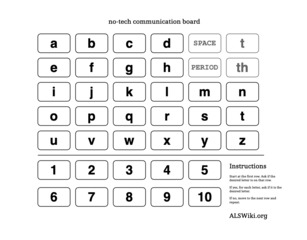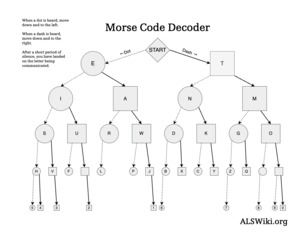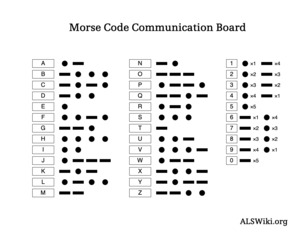¶ Introduction
Augmentative and Alternative Communication (AAC) refers to methods and tools used to support or replace spoken or written communication for individuals with speech or language impairments.
AAC methods and tools vary in complexity and level of assistance. Voice amplifiers simply take existing speech and increase its volume to make it easier to hear. Speech generating devices take motor input, such as key strokes and convert them into generated speech. Binary signaling can be used as a last resort, when speech generating devices are not accessible or not practical to use.
An individual with ALS may use a variety of different AAC methods during the course of the disease.
¶ Voice Amplification
🚧
¶ Speech-Generating Devices
🚧
¶ Text-to-Speech
🚧
¶ Binary Signaling
Binary signaling is a method of communication that uses two distinct states or signals to convey information. By linking multiple binary digits, or bits, much more complex communication signals can be transmitted. This includes human speech.
Binary signaling methods of communication are typically used when speech is virtually impossible, and mobility has precluded the use of adaptive equipment, such as keyboards or speech generation devices.
¶ Methods
Anything that can exist in at least two distinct states is capable of binary signaling. The table below provides examples of various binary signaling methods.
Table: Examples of binary signaling methods
| Table: Examples of binary signaling methods | ||
|---|---|---|
| Method | 1 | 0 |
| Numbers | 1 | 0 |
| Light | On | Off |
| Electricity | High voltage | Low voltage |
| Eye movement | Short blink | Long blink |
| Facial expression | Smile | Frown |
| Finger tapping | One tap | Nothing |
| Limited speech | Groan | Silence |
Human speech can be transmitted through binary signaling by mapping sequences of bits to letters in the alphabet. The most well-known example of this is Morse code. Another example is a communication board, where the person communicating selects a letter by either accepting or rejecting the options presented to them. This process of acceptance or rejection corresponds to the binary values of one and zero, respectively.
¶ Communication Boards
A communication board is a tool designed to aid non-verbal communication. It typically includes the full alphabet, along with common phrases and important messages, such as those used to convey emergencies.
Simple communication boards, colloquially known as "no-tech boards", are a piece of paper or cardboard. The desired letter or symbol can be pointed to if the user is able; otherwise, an assistant may point to each letter one by one and ask the user yes or no if the letter being pointed to is the correct one.
Communication boards can also be included in PC or mobile phone software. They can support advanced features such as eye gaze and word completion.
No-tech boards may be too tedious for daily use, but they are easy to learn and don’t require electronics, making them useful during power outages or when working with inexperienced assistants.

No-tech communication board
¶ Morse Code
Morse code is a largely obsolete binary communication system whereby every letter of the alphabet, numbers, and some punctuation are mapped to a sequence of dits (dots) and dashes. The sequences for each letter in the alphabet were heavily optimized during development of the coding, as the frequency of use of various letters in the alphabet varies greatly.
Some individuals that have worked in the telecommunications industry or military may know parts or all of the Morse code alphabet. Most individuals are not familiar with Morse code, other than through popular culture references, typically referring to SOS, a shorthand for the declaration of an emergency.
It is possible to communicate effectively using Morse code without either person having any of the letter sequences memorized.
In order to use Morse code without memorization:
-
The speaker must be able to look up the Morse code sequence for the letter they are trying to communicate and then form the sequence for it, using some means such as blinking or groaning.
-
The listener must be able to look up the letter for the Morse code sequence that they have received from the speaker.
ALSWiki.org has developed an easy-to-use communication board for Morse code which satisfies both requirements.
The use of Morse code may be faster than a traditional communication board, especially if one person has the sequences memorized. In time, memorization may occur between some individuals.

